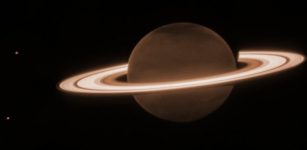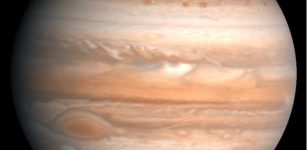Water Mysteries Beyond Earth: Ground-Penetrating Radar Will Seek Bodies Of Water On Jupiter
Eddie Gonzales Jr. – MessageToEagle.com – Scientists describe how ground-penetrating radar is used to discover bodies of water below the surface of distant planets and they are on their way to Jupiter.
This full-disc image of Jupiter was taken on 21 April 2014 with Hubble’s Wide Field Camera 3 (WFC3). Image credit: NASA, ESA, and A. Simon (Goddard Space Flight Center) – source
Finding water on distant planets and moons in our solar system is a challenge.
The first clue for finding life on other planets is finding liquid water. The moons of Saturn and Jupiter like Enceladus, Ganymede, Europa, and Callisto are suspected of holding oceans of liquid water beneath icy crusts. Similarly, some exoplanets beyond our solar system likely host liquid water, crucial for habitability. But detecting water, when we can’t physically access these celestial bodies, poses challenges. Ice-penetrating radar, a geophysical tool, has proven capable of detecting liquid water on Earth and beneath Mars’ South polar cap.
Now, this instrument is aboard the JUICE spacecraft and it is on its way to Jupiter’s icy moon Ganymede and will also be aboard the Europa Clipper spacecraft, which will be launched to Europa later this year. What can we expect to learn from these missions and how can we use ice-penetrating radar for future planetary exploration? Dr. Elena Pettinelli of Roma Tre University, with extensive experience in planetary exploration using ice-penetrating radar, will delve into the utility of this technology in her presentation next week at the European Geosciences Union General Assembly EGU24.
Dr. Pettinelli, who was part of the team that discovered a subglacial stable body of liquid water on Mars, will trace the historical applications of ice-penetrating radar in planetary exploration before she dives into prospective uses of ice-penetrating radar in locating and characterizing liquid water.
Scientists hope to use ice-penetrating radar to determine the depth and chemistry of water beneath the icy surface of Jovian moons. Dr. Pettinelli explains that the radar’s penetration depth correlates with ice salinity; saltier ice impedes radar transmission to a greater extent.
“Depending on the behavior of the radio waves, we might be able to better tell the distribution of salt,” she says, which her team then ground-truths through laboratory experiments.
“We can use all this information to improve our understanding of the distribution of liquid water in the solar system,” Dr. Pettinelli says. “There’s much more water than we thought 20 or 30 years ago, and it’s really interesting to use this technique to try to understand where the water could be.”
Written by Eddie Gonzales Jr. – MessageToEagle.com Staff Writer











